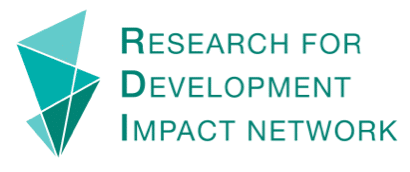What is the point of this document?
The ‘Enhancing Research Impact in International Development’ (ERIID) is a practical guide that provides a step-by-step process on how to ensure that development research has an impact. The framework is crafted to maximise the effects of research from beginning of planning to past its completion date.
Who wrote it?
The Research for Development Impact Network (RDI Network) developed this practical guide in partnership with the Humanitarian and Development Research Initiative (HADRI) at Western Sydney University.
Who is it meant for?
This guide is for researchers and practitioners in the development sector. It is particularly helpful for those new to the sector, and for others who are wanting to maximise their impact. This includes maximising the impact of program evaluations, and Monitoring and Evaluation (M&E) findings.
Why should I read it?
Not all research and/or evaluation findings result in positive impact. The ERIID provides the necessary discourse, tools, and strategies to ensure positive, tangible impact for funders, donors, and local communities.
Key Takeaways:
- Engaging local community and building goodwill. The aim of research being conducted in any development environment is to provide evidence of positive impact for the targeted audience. This means that discussions need to occur with the local community to define ‘positive’ and ‘impact’ together with researchers. It is imperative that local community perspectives are included in the research objectives.
- Understand the local context. Additionally, it is critical to understand the factors that co-exist in the environment where we work. This includes understanding political, policy, socio-cultural and local customs. These factors will ensure that the research is relevant to the local community.
- Ask yourself why. It is time to ask why this research is being done. How will it contribute to the community? Will the results (positive, neutral, or negative) benefit or harm the local community? When planning for impact it can be more beneficial to understand what you want the end to look like first. Working backwards through the planning stage invites time to practice reflexivity and ask these questions.
- Proactive engagement. Continuously ensure that there is proactive engagement with the local community. At the end of the day, the research findings will influence (through policy recommendations) the local community and its residents. These are real people, and real impacts. This means local research partners need to be involved in co-production of knowledge.
- Tailored research outputs. Importantly, the research outputs need to be tailored to those you want to engage (e.g. the local community, the academic world, development practitioners, policymakers etc.). Outputs must be specifically created based upon what is appropriate for your targeted audience. Identify what is used in the community and implement this as an output. Music, dance, and art are alternative outputs that can increase local research impact and engagement.
- Continue those relationships. Finally, the relationships built over the course of a research project must not end correspondingly with the research. A transactional nature towards the local community and participants does not build goodwill. Endevour to thank those involved for their time, expertise, and resources into the project. Maintain a lasting engagement with your partnerships. This provides a welcoming environment for future engagement.
Section Outlines:
- Section 1 provides the foundational aspects that must be considered prior to the commencement of a research project. It is a good stepping-stone to understand and be aware of the broader influences in the development sector to set your project up for success.
- All projects need to have an adequate plan in place; however, it is especially important to have a strategic plan to ensure that the outcomes of the research are accessible and appropriate for the targeted audience. Section 2 provides templates, as well as, self-reflective questions to ask yourself when constructing this plan.
- Section 4 is beneficial if you are looking for options to tailor your research outputs and knowledge products. There are a variety of examples, tools, and techniques that are ideal as alternative methods to a report.
Link:
- Enhancing Research Impact in International Development: A Practical Guide for Practitioners and Researchers (90 min read, PDF)
- Published in 2020



